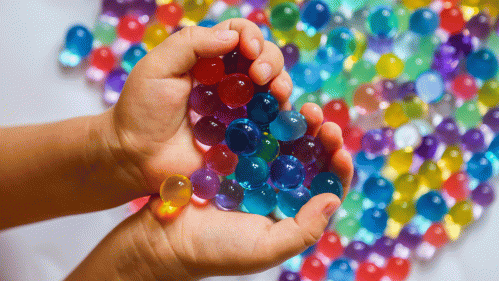Water Beads’ Hidden Dangers

A Rutgers Poison Control expert discusses the health risks posed to children from this popular toy, which lawmakers are seeking to ban
Water beads are tiny, colorful, expanding gel balls often sold as crafts, toys or sensory tools for children with developmental disabilities. However, if ingested, they can cause vomiting, intestinal blockages and may be fatal if left undetected.
Both the federal government and the state of New Jersey have introduced bills to ban their sale.
Between 2016 and 2022, the Consumer Product Safety Commission estimates 7,800 emergency room visits were associated with water beads, which can also be found in docorations, like floral arrangements. Diane Calello, medical director of the New Jersey Poison Control Center at Rutgers New Jersey Medical School, has seen calls about water beads increase sharply.
Calello addresses what parents need to know.
What are water beads?
These small round beads may be sold in craft kits, as home decor and for use in flower arrangements, and even as sensory toys for children with developmental disabilities. They are brightly colored and very enticing. But they contain a super-absorbent material which allows them to grow up to 100 times their original size. They start as small as tiny pebbles but can grow large enough to block a young child’s intestine or airway.
Can you tell us more about the dangers associated with water beads
Because they are small toys, initially they present a choking hazard. After being swallowed, however, they can block any component of the GI tract, including the stomach and intestine. This can cause vomiting, dehydration, intestinal blockage, infection and even death. Emergent surgery may be needed to remove the beads from the intestine.
What are signs that a child has ingested water beads?
Unless the ingestion is witnessed, the first signs will likely be gagging, vomiting or refusal to eat or drink. This may progress to worsened vomiting, abdominal swelling, pain, fever and a change in behavior.
While some of these may be seen on X-ray, they may not because they are clear and don’t contain any metal. If the parent is unsure, the care team may choose to observe the child in the hospital for the development of symptoms or signs of obstruction.
How is a child treated?
If there is obviously a water bead in the intestine, attempts will be made to remove it via either endoscopy or surgery.
The label says “nontoxic.” But are they?
The beads contain a superabsorbent polymer, which does not have any inherent toxicity, but its chemical nature allows the bead to expand to dangerous proportions.
Beyond ingestion, what other risks do they pose?
Anytime these expanding beads get into a closed space, tissue destruction may result. There are reports about children putting the beads in their ears and the expansion causing damage to the ear and hearing loss requiring surgical repair. Another potential scenario could involve a child putting a bead in their nose. Although I’m not aware of this being reported, I would imagine that could cause significant damage to the nasal cartilage and the face.
How can parents keep children safe?
First, if you have young children in your house, don’t buy these products. Be alert to your surroundings outside the house and if you see the beads – for example, in a floral arrangement – to keep your child away from them. It’s also a good idea to discuss the availability of this and other poisoning hazards with daycare providers, babysitters and other caregivers your child may visit.


